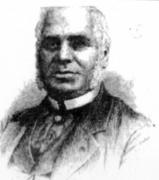|
|
||||||||||||||||||||||||
 |
Featured person
Recently added |
Cú Chonnacht Ó Cianáin ( - 1615): |
||||||||||||||||||||||
Cú Chonnacht Ó Cianáin (or in an anglicised form, Cuconnacht O’Keenan) was involved in the 1615 plot, known as the “Natives’ Rebellion”, which led to him becoming the first person in Ireland known to have been judicially tortured on the rack.
The year 1614 was in the midst of the Ulster Plantation, which involved key lands throughout the province (except Counties Antrim and Down in the east) being settled by individuals loyal to the London government, most from England and Scotland though some were “native” Irish. In May some native Irish who wished to resist this plantation met in an alehouse (pub) at Macosquin, on the River Bann and made plans, not well thought through, to attack and seize several principal towns in north-west Ulster. They planned to achieve this, moreover, with a notable paucity of weapons.
Ó Cianáin was a brother of Taghdh O’Keenan, who was a close associate of the Earls of Tyrone and Tyrconnel, the Earls whose famous flight from Ireland in 1607 was a key event in the Ulster Plantation, to say the least. When in 1615, Sir Arthur Chichester, the Lord Deputy, or the King’s representative in Ireland, was pursuing those he suspected (with some justification) of plotting against the Government during the Ulster Plantation, he decided to employ judicial torture in order to obtain information about plot and plotters, and Ó Cianáin was selected; it seems, because of his connection. Contemporary opinion was rather divided as to the seriousness of the plot. Sir Robert Jacob, Solicitor-General, was not inclined to alarm; Chichester on the other hand, pointed out that there had for some months been a high level of murders of planters. There was also the shadow of the Earl of Tyrone, whom many thought could imminently invade Ireland with Spanish Army troops (some Irish); he certainly wished to and was constantly pressing King Philip III of Spain to this end. But the Spanish king, and the Pope, were anxious not to provoke London, not least as they were hoping to have the Spanish Infanta married to the British King James’s son Charles (this proposed marriage deal was known as the “Spanish Match”, was organised in part by the clever Spanish envoy to London, Gondomar, and immortalised in drama by Thomas Middleton in his play A Game at Chess).
Among modern historians, one theory is that Chichester, whatever he saw as real dangers, made use of the plot to force through the Parliament a request for increased government revenue, pleading that the threat to security in the province warranted this.
In July, seventeen plotters were tried before the two assize judges for County Londonderry and a jury which included two native Irish. Eleven were acquitted for lack of evidence; six were convicted, and sentenced to be dragged through the streets of the city, then hanged, drawn and quartered. Cú Chonnacht Ó Cianáin was one of these, Brian Crossagh O’Neill another. However, whereas sentence was carried out on O’Neill almost at once, the others sentenced to death had to wait. This was a concern for Chichester, who in September wrote to the King of his worry that the remaining convicted might escape or be rescued. However, a prison roll some time later recorded against Cú Chonnacht Ó Cianáin’s name the simple entry “ss” – a Latin abbreviation for suspensus, - hanged.
| Born: | |
| Died: | 1615 |
| Richard Froggatt |
| Bibliography: Raymond Gillespie: Conspiracy: Ulster Plots and Plotters in 1615; Belfast, Institute of Irish Studies, Ulster Association for Irish Historical Studies, 1987; Jonathan Bardon: The Plantation of Ulster, Dublin 2011 |


Home | Our Policies | Plaques | Browse | Search | Sponsors | Links | Help | Contact
Privacy & Disclaimer | Cookie Policy | Site Map | Website Design By K-Point
© 2024 Ulster History Circle









